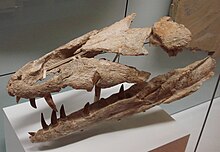Geosaurinae is a subfamily of metriorhynchid crocodyliforms from the Middle Jurassic to the Early Cretaceous (Bathonian - Aptian) of Europe, North America and South America.[1][2][3] Named by Richard Lydekker, in 1889, it contains the metriorhynchids Suchodus, Purranisaurus, Neptunidraco, Tyrannoneustes, Torvoneustes, Dakosaurus, Geosaurus and Plesiosuchus. The last five taxa form a tribe within Geosaurinae, the Geosaurini. Geosaurinae is one of two subfamilies of Metriorhynchidae, the other being Metriorhynchinae.[4]
| Geosaurines Temporal range:
| |
|---|---|

| |
| Dakosaurus maximus skull, Staatliches Museum für Naturkunde Stuttgart | |
| Scientific classification | |
| Domain: | Eukaryota |
| Kingdom: | Animalia |
| Phylum: | Chordata |
| Class: | Reptilia |
| Clade: | Archosauria |
| Clade: | Pseudosuchia |
| Clade: | Crocodylomorpha |
| Clade: | Crocodyliformes |
| Suborder: | †Thalattosuchia |
| Family: | †Metriorhynchidae |
| Subfamily: | †Geosaurinae Lydekker, 1889 |
| Genera | |
| |
These marine reptiles were widespread during the Late Jurassic and Early Cretaceous, their fossilized remains are being frequently found on various places around the world.[5]
Phylogeny
editGeosaurinae is a stem-based taxon defined in 2024 as the largest clade within Metriorhynchidae containing Geosaurus giganteus, but not Rhacheosaurus gracilis, Metriorhynchus brevirostris, and Gracilineustes leedsi.[6] The derived tribe Geosaurini was named by Lydekker in 1889, and it is a node-based taxon defined by Mark T. Young and colleagues in 2024 as the smallest clade within Metriorhynchidae containing Tyrannoneustes lythrodectikos, Geosaurus giganteus, Torvoneustes carpenteri, and Dakosaurus maximus.[6] There are many subclades within Geosaurini, namely Dakosaurina, Geosaurina, Plesiosuchina, and the lineage containing Torvoneustes and relatives.[7] [6] Geosaurina contains the genera Geosaurus and Ieldraan and defined as "the largest clade within Metriorhynchidae containing Geosaurus giganteus, but not Metriorhynchus brevirostris, Plesiosuchus manselii, Torvoneustes carpenteri, and Dakosaurus maximus".[6] The clade Plesiosuchina contains Plesiosuchus and Suchodus and is defined as "the largest clade within Metriorhynchidae containing Plesiosuchus manselii, but not Metriorhynchus brevirostris, Geosaurus giganteus, Torvoneustes carpenteri, and Dakosaurus maximus".[6] Most recently, the clade Dakosaurina was formally named and defined by Mark T. Young and colleagues in 2024 as "the largest clade within Metriorhynchidae containing Dakosaurus maximus, but not Metriorhynchus brevirostris, Geosaurus giganteus, Plesiosuchus manselii, and Torvoneustes carpenteri.[6] The cladogram below follows the topology from a 2020 analysis by Young et al.[7]
| Geosaurinae |
| |||||||||||||||||||||
References
edit- ^ Mark T. Young; Marco Brandalise de Andrade (2009). "What is Geosaurus? Redescription of Geosaurus giganteus (Thalattosuchia: Metriorhynchidae) from the Upper Jurassic of Bayern, Germany" (PDF). Zoological Journal of the Linnean Society. 157 (3): 551–585. doi:10.1111/j.1096-3642.2009.00536.x.
- ^ Mark T. Young; Stephen L. Brusatte; Marcello Ruta; Marco Brandalise de Andrade (2010). "The evolution of Metriorhynchoidea (Mesoeucrocodylia, Thalattosuchia): an integrated approach using geometrics morphometrics, analysis of disparity and biomechanics". Zoological Journal of the Linnean Society. 158 (4): 801–859. doi:10.1111/j.1096-3642.2009.00571.x.
- ^ Chiarenza AA, Foffa D, Young MT, Insacco G, Cau A, Carnevale G, Catanzariti R (2015). "The youngest record of metriorhynchid crocodylomorphs, with implications for the extinction of Thalattosuchia". Cretaceous Research. 56: 608–616. doi:10.1016/j.cretres.2015.07.001. hdl:2318/1537833.
- ^ Andrea Cau; Federico Fanti (2011). "The oldest known metriorhynchid crocodylian from the Middle Jurassic of North-eastern Italy: Neptunidraco ammoniticus gen. et sp. nov". Gondwana Research. 19 (2): 550–565. Bibcode:2011GondR..19..550C. doi:10.1016/j.gr.2010.07.007.
- ^ Daniel Madzia, Sven Sachs, Mark T. Young, Alexander Lukeneder and Petr Skupien (2021). Evidence of two lineages of metriorhynchid crocodylomorphs in the Lower Cretaceous of the Czech Republic. Acta Palaeontologica Polonica. doi: https://doi.org/10.4202/app.00801.2020
- ^ a b c d e f Young, Mark T.; Wilberg, Eric W.; Johnson, Michela M.; Herrera, Yanina; De Andrade, Marco Brandalise; Brignon, Arnaud; Sachs, Sven; Abel, Pascal; Foffa, Davide; Fernández, Marta S.; Vignaud, Patrick; Cowgill, Thomas; Brusatte, Stephen L. (2024). "The history, systematics, and nomenclature of Thalattosuchia (Archosauria: Crocodylomorpha)". Zoological Journal of the Linnean Society. doi:10.1093/zoolinnean/zlad165.
- ^ a b Young MT, Sachs S, Abel P, Foffa D, Herrera Y, Kitson JJ (2020). "Convergent evolution and possible constraint in the posterodorsal retraction of the external nares in pelagic crocodylomorphs". Zoological Journal of the Linnean Society. 189 (2): 494–520. doi:10.1093/zoolinnean/zlaa021. hdl:11336/137182.